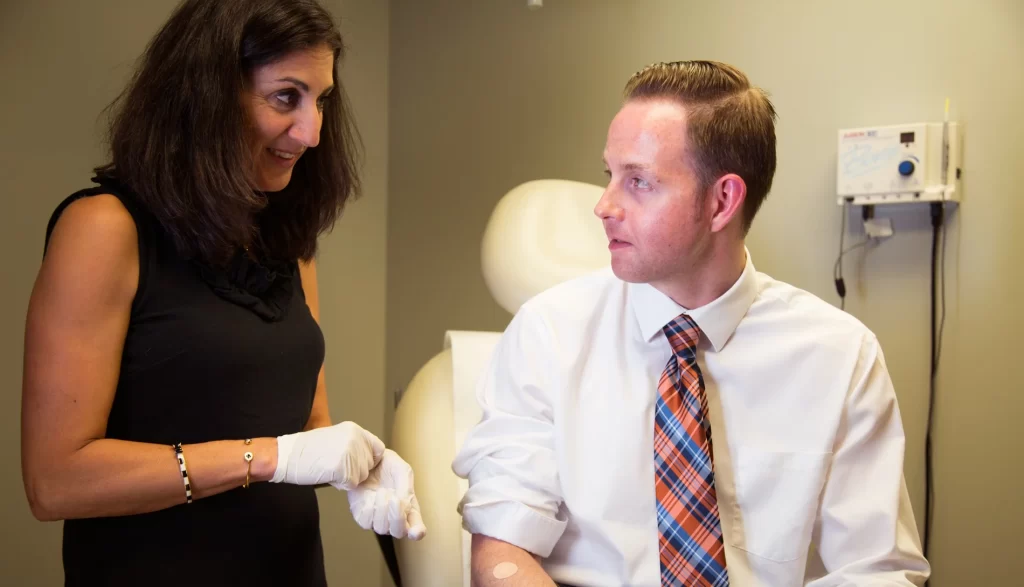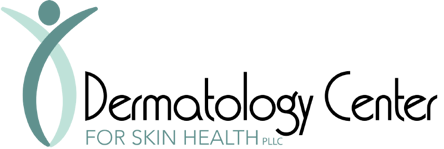When you think of acne and other skin condition treatments, your first thought may not be photodynamic therapy (PDT), also known as light therapy.
WHAT IS PHOTODYNAMIC LIGHT THERAPY?
PDT is a non-invasive therapy that uses multiple sessions of light treatments in conjunction with a photosensitizing agent. The photosensitizing agent, such as 5-aminolevulinic acid (ALA or Levulan), is an inactive medication that only activates when exposed to ultraviolet radiation or sunlight. The ALA (Levulan) is administered directly on the skin. A blue light is then applied to activate the Levulan.
WHAT DOES PDT TREAT?
PDT is a FDA-approved treatment of actinic keratosis, which are precancerous cells on the face and scalp.
PDT can also be effective for:
- Acne
- Sun-damaged skin
- Skin infections
- Rosacea
- Wrinkles
- Warts
- Psoriasis
- Hidradenitis suppurativa (lumps under the skin commonly found in the armpits or groin)
WHO IS A GOOD CANDIDATE FOR PDT?
Good candidates for PDT are typically light skinned individuals who have sun damage.
You may not be a good candidate if any of these apply:
- darker skin tones that tend to burn with light or laser therapy
- sensitivity to light; naturally or because of medication
- sunburn easily
- inability to stay out of of the sun for a period of 24 to 48 hours
- have medical conditions like Lupus
BEFORE, DURING AND AFTER PDT TREATMENT

During your consultation, the dermatologist will review your medical history as some medical conditions can affect the procedure and the overall healing time.
Always tell your dermatologist if you:
- take medications that make you sensitive to light
- have medication allergies
- have had prior PDT treatments
- had a staph infection or cold sores
- have any other medical conditions
Prior to treatment
At your consult appointment, the dermatologist will discuss your best treatment options, how many treatments may be necessary, what to expect, what to bring and the post-treatment instructions.
Generally, patients are asked to come to their appointment with the treatment area washed areas free from all body lotion, moisturizer, sunscreen and makeup. Patients are welcome to eat their regular diet of food that day and encouraged to wear comfortable clothing. Depending on your treatment area, you may be asked to bring a wide-brimmed hat, sunglasses, scarf, gloves, or a long-sleeved shirt.
Smoking, as well as drinking, can interfere with your healing process. The dermatologist may ask you to stop smoking and refrain from heavy drinking, for a few days, prior to your procedure and up to two weeks after your treatment.
Most patients can drive home; however, if you are concerned about pain tolerance level, you may ask someone to transport you.
During treatment
The treatment area will be cleansed with acetone. The ALA will be applied directly to the skin and the incubation period of 60 to 120 minutes will begin. Following the incubation period, your 20 to 30 minute blue light treatment to activate the Levulan will begin.
During treatment, patients are encouraged to bring with them light reading material or music.
Post treatment
Recovery from PDT is fairly simple and you may be able to resume your normal daily activities. Your dermatologist will request you stay out of the sunlight for 24 to 48 hours and may apply non-irritating sunscreen to the area before you leave the office.
Wash the area with a gentle soap and water. Do not pick at the dry affected area as this can cause irritation and scarring. Patients are also encouraged to avoid wearing any makeup on the affected area during the time of recovery.
Patients may encounter mild swelling, especially if the procedure was around the eyes or lips. It is recommended to apply cold ice packs to the affected area for five to 15 minutes every hour during the first eight to 24 hours.
If the patient experiences infections, cold-sores, extreme swelling, fevers or any other reactions not discussed by the dermatologist, you should contact the dermatology office.
ARE THERE ALTERNATIVE TREATMENTS INSTEAD OF PDT?
There are alternative treatments for actinic keratosis and other skin conditions you may be facing. Actinic keratosis can be treated with cryotherapy, chemical peels and scraping.
To learn more about chemical peels and our other cosmetic procedures, click below:
PDT has its advantages for treating acne including killing acne-causing bacteria, affecting only the targeted areas, decreasing the size of sebaceous glands, fading old acne scars and can be used with other medications, excluding Accutane treatment. But, if you are looking for other treatment options, acne can be treated with Accutane, and other acne medications including salicylic acid, benzoyl peroxide, alpha hydroxy acids, topical retinoids, oral antibiotics and extractions. PDT for the treatment of acne is typically not covered by insurance.
To learn more about acne treatments, other than PDT, click below.
HOW CAN WE HELP?
The Dermatology Center for Skin Health, PLLC, is dedicated to giving you the most up-to-date knowledge about our treatment options so that you can make the best informed decision about your plan of care.
If you have questions about PDT or acne/other skin conditions that you may be facing, give us a call at 304-598-3888, or click below:
Topics: Acne/Rashes


